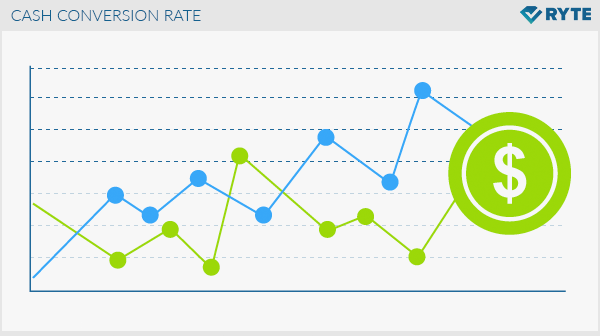Cash Conversion Rate
The cash conversion rate (CCR) is an economic statistic in controlling that represents the relationship between cash flow and net profit. The cash conversion rate is always determined with reference to a specific time period, for example, for a quarter or year. The cash conversion rate can, therefore, be interpreted as the ability of companies to convert profits into available cash. Because of the time reference, it is a quantity that gives information about the duration of capital commitment. This is the rate at which a company can turn cash outflow into cash inflow.
General information
The cash conversion rate is a relatively recent instrument used primarily in the industrial sector. In contrast to the price-earnings ratio, which allows a comparison between the equity values of different companies and is thus relative, the cash conversion rate is an absolute measurement which measures the actual liquidity of a company. For this reason, the CCR is an important tool for financial investors and an indicator of the financial health of a company.
In addition, the cash conversion rate is viewed along with growth ratios in order to find out how growth relates to the actual profit. That way, factors such as capital efficiency, turnover, and profitable growth can be assessed, for example, to prevent bubbles. Specifically, this means that young growing companies, such as start-ups, are trying to reach a turning point where the investments made are paid off, and the company is profitable.
Calculation of the cash conversion rate
Cash flow is the basis for calculating the CCR. There are essentially two ways to determine the cash flow. On the one hand, all company profits can be used to pay off investments. Direct determination deducts all operating expenses such as wages, material costs or taxes on income, such as sales revenues or divestments (for example, sales of company shares). On the other hand, the overall balance sheet of a company can be used. The indirect determination would initially add depreciation or provisions and then subtract earnings-neutral income and appreciation in value.
Once the cash flow is determined, this value can be divided by the profit after tax. If the cash conversion rate is greater than 1.0, it is usually a positive sign because funds will be available for investments and dividends for investors. If the value is negative, the company is having financial losses in its current activities and is not liquid. The formula for the cash conversion rate in short form:
CCR = cash flow / net profit
Cash conversion rate example
Siemens uses the cash conversion rate within the framework of control instruments, which lead to effective working capital management. In 2006 the CCR was 0.64. Starting in 2006, the company took various actions to specifically increase the CCR. For example, a reduction of overdue receivables by 50% or payment targets, which are tailored to customers and suppliers. In 2007, the value for the first six months was 1.11. It can be assumed that this is a consequence of the actions taken. In 2013, however, the CCR was only 1.11, which is attributable to high investments and acquisitions of other companies. The funds were used to optimize their portfolio.
Relevance to online marketing
The cash conversion rate values in online marketing should be relatively high compared to the industrial sector. If a customer orders an item online, the merchant generally does not deliver it until a payment has been received or at least the receipt of payment is expected within a short time. This results in a high CCR overall. Companies such as Amazon are pushing this principle to the extreme. They only pay their suppliers when the money has been received from the customers. Therefore, Amazon CCR values are even higher.
However, factors such as inventory and high stock levels have a negative effect on cash flow, since these funds are deducted from the calculation. Business models such as drop and ship or digital goods such as eBooks or podcasts are exceptions. In the industrial sector, it may take six months to make investments pay off. In online marketing, these processes are much more short-lived. Start-ups and young companies, in particular, make high investments, particularly at the beginning of their business activities, which negatively affect the availability of funds. Therefore, the time context, type of industry, and the business model are decisive for online marketers when using the cash conversion rate to assess and optimize the company.

